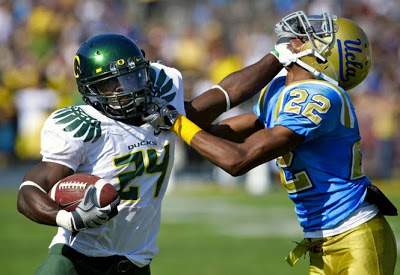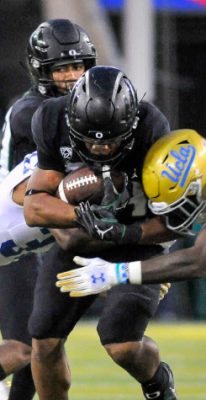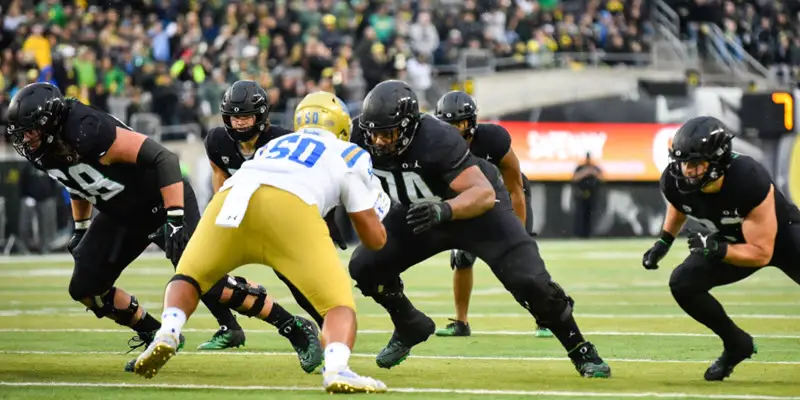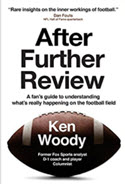Coach Mario Cristobal had to be thankful that UCLA made a ton of mistakes in Chip Kelly’s return trip to Autzen Stadium. The Bruins are very young, with fewer senior starters than Oregon: one on offense and two on defense — which might account for the five turnovers and 11 penalties, not to mention a flurry of dropped passes.
Cristobal spent the week talking about getting back to running the ball and being physical, and the results were better than the last game against Arizona, but still mediocre against a flimsy UCLA defense. The Ducks were able to average 4.8 yards per rush and 200 yards running the ball, although 65 came in the fourth quarter.

Remember when Kenjon Barner burned everyone in the open field?
Kelly, on the other side of the field, said (when he was Oregon’s main man) that the reason for the spread formation was to run the ball; spread the defense, make them defend from sideline to sideline, which amounted for Pac-12 rushing titles every season during his time as a Duck.
Oregon’s approach for running the ball now seems to set massive formations, tightly packed and attempting to over run unblocked defenders. It is a drastic change from what went down before when Kelly left for greener pastures. The Ducks now struggle to run the ball when they most need to; it seems the answer to everything is to pack more mediocre blockers into the formation and go hand-to-hand.
That strategy is the same as the Allies had in World War I where they bombarded the enemy in a restricted area of land called Verdun. The enemy bombarded back and hundreds of thousands of men were lost. The strategy did not put any pressure on the enemy to move and the generals were lost in a strategy that might have made sense in the 1500s, but was no use in the 1900s.
The Ducks playing “physical” on offense have lost their traditional ability to go fast and pressure a defense. The most physical play of the season came against Washington when Oregon scored a decisive touchdown on an inside running play that was called against a loose pass defense.
UCLA (above) has amassed eight defenders in the box and rather than trying to block 3-on-2 in the middle, the Ducks run to the outside. CJ Verdell runs for five yards and shows that you don’t have to run it up the gut to be “physical.” Verdell appears to be ideal as a short-yardage runner of which makes it a mystery when there are smaller, less physical runners chosen for short yardage situations.
The Ducks (above) run the same play to the other side. The offensive line’s pad level is too high to get leverage, including Dallas Warmack (No. 75) who can’t stop penetration and is actually getting pushed backwards by the defender he’s trying to block. Verdell battles and actually gains three yards.
Oregon, anticipating man coverage above, chooses a pick play to pick up the first down. Brenden Schooler (No. 9) releases too far inside and not enough straight up the field to set up the safety to be picked or rubbed. As a result, the defender is able to quickly adjust and cover Jaylen Redd who doesn’t have enough room to get as open as quarterback Justin Herbert would have preferred.
Herbert throws a poor pass, one of many that he threw on short outside routes. He should be running behind the ball on these routes, which means that he is square to the receiver and running straight towards him, not towards the sideline. Herbert throws a lot of these passes short and in the dirt when he doesn’t square up. Herbert was poor on third-and-short passes; throws that should be easy for him.
The Bruins’ punter (above) kicks the ball 44 yards to return man Ugo Amadi. Six UCLA cover men over run Amadi thanks to excellent shield blocks by hustling Duck blockers. A huge gap opens up the middle and Amadi gets key blocks by Matt Mariota (No. 44) and Adrian Jackson (No. 29) to seal the deal.
This is one of the best blocked returns the Ducks have had in several years; credit the return men for hustle and executing perfect blocks without any block-in-the-back penalties that often mitigate a good kick return.
UCLA (above) presents an eight-man rush for this field goal attempt by Oregon. But wait, who would have thought: it’s a fake! Holder Blake Maimone does a great job of bringing the snap down and placing it very briefly to draw the rushers and kicker Adam Stack follows through with a fake kick; both of these hold the rushers on Oregon’s right side and make them believe it’s a kick.
Maimone heads outside to the right and dumps the ball to wing back Jacob Breeland as tight end Drayton Carlberg (No. 90) clears the outside defender deep enough to allow the completion in front of him. Carlberg is a defensive lineman by trade, but his position as end man on the line of scrimmage and number make him an eligible receiver.
Breeland shakes off the tackle of a Bruin defender who could have stopped the Duck before he gained the necessary yardage for the first down, and ultimately runs down to the one-yard line.
Oregon’s short yardage play selection does not always make sense, and above is an example. UCLA has nine defenders lined up on eight offensive players; the Ducks don’t have an extra blocker for the gap the running play is designed to go.
There are two blockers for three defenders where Travis Dye, backup running back is headed; there is no chance this play will succeed against a decent Pac-12 defense. Additionally, Dye has been stopped several times in similar short yardage situations and does not have the power to run over an unblocked defender coming hard.
Making matters worse, the Ducks motion wide receiver Schooler back into a tight formation, which does little more than bring another defender to the area coach Cristobal wants to run. Dye, never having a chance of making the first down, gets stoned behind the line of scrimmage and power runners Verdell and Cyrus Habibi-Likio languish on the bench, their particular short-yardage talents wasted.
DUCKS HEAD TO SALT LAKE CITY FOR A BRAWL

Sometimes — too many defenders…
Coach Cristobal’s Ducks are, with the victory over UCLA, now eligible for a bowl. Word last weekend was that Utah lost their quarterback to injury. If such is the case, it could be a mite easier for Oregon this weekend. However, the Ute’s defense is still intact and they are the best in the Pac-12.
It will be interesting to see Oregon’s strategy going into the game. Herbert escaped the UCLA game without taking any punishment, which should help. Justin needs to polish his throwing skills that eroded in the WSU and Arizona games where he took a lot of punishment from shaky pass protection.
His short sideline throws need to hit the receiver in the chest and he needs to get back to the precision fundamentals that made him the most consistent passer in the league through the first six games. Duck coaches need to establish a pass strategy that uses all receivers, not just Dillon Mitchell. Herbert has made some poor throwing decisions lately trying to get the ball to Mitchell when he’s covered and not targeting other receivers in other areas.
Coach Ken Woody
Eugene, Oregon
Top Photo by Kevin Cline
Mike Bellotti, ESPN analyst and Former-Oregon coach: “Ken Woody’s ability to break down the game with interesting, entertaining insights comes from a career as a college player and coach, influenced by some of the top coaches in football. Woody spells it out in a simple, refreshing, humorous manner.”
Dan Fouts, NFL Hall of Fame, Oregon Ducks quarterback: “Entertaining and easy to understand.”
“Every Oregon fan should have a copy to learn from as I do.” Charles Fischer
Buy the book here to learn from Coach Woody, or give a gift of football, a great gift for the fan who wants to learn and enjoy more of the Duck (or whoever your favorite team is) football experience.
Ken Woody is a former Fox Sports football commentator who played defensive back, receiver and kicker for Oregon from 1966 to 1970. He coached college football for 18 years, including stints as an assistant coach at Oregon, Washington, Washington State and Utah State, and was head coach at Whitman College and Washington University-St. Louis. He writes x’s and o’s, a weekly column in the Register-Guard, RG online coverage of Duck football and is the author of “After Further Review—an inside look at what’s really happening on the football field.” Woody is on KUGN (590 am) 2:45 before kickoff and 30 minutes after each game with coaching and game analysis.
Ken also conducts weekly coaching clinics for fans at Eugene’s Valley River Inn every Thursday during football season at 6:00 PM. The clinics are free and open to the public.
“I learned football working under many great coaches, among them Len Casanova, Jerry Frei, John Robinson, Bruce Snyder, George Seifert,and Ron Stratten at the University of Oregon, Jim Owens at the University of Washington and Jim Walden at Washington State University. Most of my coaching experience was on the offensive side of the ball with quarterbacks, receivers and kickers although as a head coach I coached defensive backs, linebackers and offensive line.
I achieved my first goal of being the youngest head coach in college football at the age of 26 and throughout my career in coaching and outside of it, as a journalist and broadcaster, have experienced how exciting and gratifying it is teaching the game to others.”


